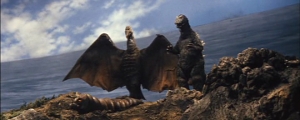
How about I take cheap shots at a film I love for a change? I seem to be running on a solid three-to-one ratio. And Japan was still synonymous with “cheap” back when this film came out, despite it being the most lavish Godzilla movie ever made…a title it would hold for a full year.
As I’ve said, with Mothra vs. Godzilla the Ishiro Honda repertory company came into the full force of its power. Its international success, combined with that of its prequel, King Kong vs. Godzilla, ensured everyone, from series producer Tomoyuki Tanaka on down, access to more cash. This allowed the Godzilla series, for a few brief, shinning years, to top itself with each subsequent entry by doing something anathema to modern Hollywood. I think they used to call it “innovating.”
Everything I loved about Mothra vs. holds true for San Daikaiju: Chikyu Saidai no Kessen (“Three Giant Monsters: Earth’s Greatest Battle“). They could’ve gone the safe route, pitted Godzilla against any of Toho’s other pre-existing monster foes, washed their hands and called it “good.” They did just that, teaming Godzilla with Rodan and Mothra. But then they went the extra mile, creating a fan favorite and reoccurring series villain in the titular (for the English-speaking markets, anyway) King Ghidorah.
Appropriately enough for a film with big ambitions, Ghidorah opens on stargazing. Since Godzilla movies traditionally come out in December, this film’s set in January. According to Our Reporter, Naoko (Yuriko Hoshi – last seen playing Yoka in Mothra vs.) it’s the hottest January on record. Just her luck, she’s stuck on a roof with a bunch of whack-jobs from the UFO Institute. They hope flying saucers and the intelligences that drive them will clue we puny humans in on what’s up with the heat wave. Presumably they’ll then carry the UFO Institute off to Heaven or something, after its worker bees take a quick drano milkshake. No flying saucers show up, but at least a freak meteor shower gives Naoko and the UFOlogists something to stare at.

Back indoors, Detective Shindo (Yosuke Natsuki) is receiving an assignment from The Chief (Akihiko Hirata – the Scientist of Rodan, The Mysterians and King Kong vs. Godzilla). Seems the Princess Selina Salno (Akiko Wakabayashi) heir to the thrown of the fictional nation Selgina (which is just like Japan, except everyone wears frilly lace collars when they’re at home), will be stopping by Tokyo on an unofficial visit. Recent political instabilities have made Her Highness’s country a dangerous place for a royal. Shindo’s given a single picture of Princess Selina and told to keep her visit on the down-low, lest rumors of a plot to assassinate her turn out to be true.
Cut to Her Highness’ private plane, where Shindo’s orders are about to become moot. A mysterious voice calls to the princess as her plane passes under that mysterious meteor shower Naoko and the UFOlogists were watching. A disembodied voice instructs her to jump out of the plane. She does, moments before it explodes, and I’ll take free fall over burning up any day.
Bummed by the news, Shindo goes home…and we discover he and Naoko are siblings, living with and supporting their dear old mom, being the kind of children we Norte Americanos can only marvel at. Why couldn’t mid-century Japanese people dump their old folks out on the sidewalk like we decent, upstanding Americans? (Thankfully, they’ve caught up to us in that department by 2011).
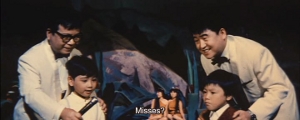
Naoko and mom, at least, choose to unwind after a hard days work with that greatest of American past-times: bad television. Shutting out Shindo’s funk, the two tune into Where are They Now? which has nothing to do with the American program of the same name, though it follows a similar “catch-up-to-the-celebrity-our-audience-picks-at-random” format. Tonight’s episode? Mothra. No, really.
Yes, two “adorable” little tykes in the shortest pair of short shorts ever stitched by human hands ask to speak to Mothra. Guess dumping Godzilla in the ocean won Infant Island’s living god a few points with the Japanese public. Enough to make up for all that unpleasantness back in ’61? Apparently. The Shobijin enter stage right and put on a telepathic min-concert for the two boys and the live studio audience. For once, no one tries to kidnap them, so things must be all good, right?
Well…not exactly. Turns out one of those meteorites came down intact in a secluded alpine valley. (Hey, Japan has Alps, too, so I get to call it “alpine.”) Professor Miura (Hiroshi Koizumi), reprising his role from the last film (maybe – wasn’t Miura a biologist in the last movie?) gets the job of investigating it, hampered somewhat by terrain and the meteor’s on-again-off-again magnetism, which is strong enough to pull the pickaxes right out of Our Scientist’s hands…almost as if some mischievous elf had tied invisible string to them.
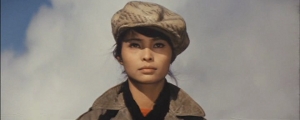
Back in civilization, Naoko’s a little down, too. Being a young woman in the early 60s, she’s the low man on the totem pole around her paranormal investigation TV show, Mystery in the 20th Century. Seeking that Big Scoop, she literally wanders into a crazy woman on a soap box, haranguing the crowd with dire warnings of impending doom. A volcano in Kyushu will soon erupt, birthing the monster Rodan (Masaki Shinohara) back into the world. Oh, yeah…and the mysterious woman (who looks an awful lot like Princess Selina) claims she’s from Venus.
You see these? These are plot threads intertwining as characters and their relationships run into dramatic complication. Each one adds a new wrinkle to the overarching story, ramping up the tension and making the climactic monster battle that much sweeter. This is a Master’s class on how to make a good monster movie. Or how to make a good movie, period.
Shindo recognizes Selina once her photo shows up in the paper. Through his powers of detection, he tracks her path through Japan, from the old docks where she washed up after jumping out of that airplane to the crater in Kyushu, where she mysteriously appears…and where her Rodan prediction turns out to be right on the money, much to the surprise of some Odious Comic Relief hecklers.
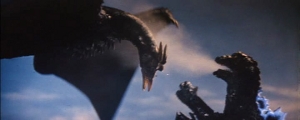
Somehow, Selina survives the flying monster’s return to the surface (never mind that both Rodans burned to a pretty thorough crisp at the end of their own movie). It’s Naoko who finds her again, warning everyone away from the ship set to ferry the Shobijin back to Infant island. Naoko and the Shobijin snap our virtuous Venusian up before the men in white coats can drag her away. Naoko even convinces her to stay put in the Tokyo Broadcasting station’s usual hotel room by telling Selina about the incredible soap box-enhancing powers of television.
Chasing his own hunches, Shindo catches up with his sister just in time to defend her, Selina and the Shobijin from Selginan assassins. Fleeing to the local Psychology Lab, run by the designated expert Dr. Tsukamoto (played by Dr. Yamane himself, Takashi Shimura, because who else would you cast as an Elderly Scientist in a mid-60s daikaiju movie?), Our Heroes learn that all this is bigger than one country’s continuity of governance. The Earth itself is doomed, just like Selina’s former home, Venus. The space monster King Ghidorah (Shôichi Hirose, last seen playing King Kong) reduced the might and advanced Venusian civilization to dust. Now he’ll do the same to Earth. “He is already here,” the obviously-possessed Selina says. “None of you believe me. I can see it in your eyes.”
On top of all that, Godzilla (Haruo Nakajima) rises from the sea, pausing just long enough annihilate that ship the Shobijin would’ve been on before making landfall and getting into a scrap with Rodan. That magnetic meteorite in the Alps (which has been steadily growing this whole time) finally cracks open, unleashing Ghidorah in all his goofy glory. Will the Shobijin once again aid Japan via Mothra? Will Earth’s monsters unite long enough to oppose the marauding alien? Will Our Heroes keep Selina alive through this miasma of monsters (human and otherwise) that beset her dramatic trail? Will that damn Venusian ever leave Princess Selina’s body? Will there be anything left when s/he does?
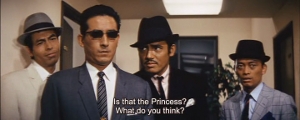
Obviously the answer to that first question is “yes,” or this movie wouldn’t be famous. But, as is my habit, I’d first like to praise the actors for once again being this film’s saving grace and its more-or-less-unsung heroes. Hoshi and Natsuki are wonderful adult siblings, ripping on and building up each other in equal turn. They have the quiet, chummy chemistry of people who’ve known each other all their lives and obviously grew up in a single parent household. (I think we’re all supposed to know which war kept their dad from coming home.)
On the other end of the spectrum, there’s Akiko Wakabayashi (another King Kong vs. veteran – she was the one with the coconut shells on her boobs) and her creepy/sexy eyes. As a Venusian possessing a Terran body, she gives us a performance so intense she could just be playing a crazy person…if only the things she said didn’t have such a nasty habit of coming true. I don’t care what language she’s speaking, my spine still shivers whenever she starts talking about Venus’ destruction. Not even the presence of electrodes on her head, or the infuriating, round-about way she has of never directly answering questions, can stop me from smiling. Even Dr. Tsukamoto a little freaked out by those dead eyes. “It’s like we’re being examined.” And found wanting, Doc.
I love how its the Shobijin who initially propose an alliance of Earth’s monsters against Ghidorah. I love that they appear before the Diet to propose this formally, like the diplomats they so obviously are. (After enduring two attempted kidnappings on Japanese soil, I think they’d at least rate a full-time military security escort.) I love the slow, down-tempo remix of the Mothra song, and the Ito Twins voices are as welcome as always. By this point, they’d become the closest thing to reoccurring human characters in this series.
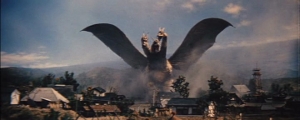
But who cares about that, right? We’re all here for the monster fighting, and Ghidorah won’t disappoint there. It’s entire back third is a showpiece of suitmation choreography and a monument to Eiji Tsuburaya’s special effects shop in its prime.The one-on-one between Godzilla and Rodan that Mothra breaks up, and the climactic three-on-one monster brawl, are all technical achievements that don’t get their fair due because those are stuntmen in costumes. You’d think that would impress people even more, but it generally doesn’t.
Indeed, the final fight and Ghidorah’s attack on Tokyo (where else is he gonna go, Detroit?) both turned out so well, pieces of them would reappear in almost every Godzilla movie this side of 1975 (the end of Godzilla’s original film series). The next ten years of Godzilla film would each attempt in their own way to top this one, and for my money, they’d all fail.
This is the Godzilla movie to beat because here human drama and SF goofiness finally achieve balance, something Raids Again and King Kong vs. lacked, while Mothra vs. looses points for working off a cheat-sheet. With Ghidorah, the mix is finally correct thanks to the economy of Shinichi Sekizawa’s script (his third in the series), the energy in Honda’s direction, and the sheer balls required of everyone to do a monster movie this “high concept.”

Honda took to wide-angle “Tohoscope” photography like a radioactive monster to a uranium mine, and he keeps throwing these strange morality plays together out of thematic juxtapositions. In the lead up to the climactic battle, Our Selganan hitmen learn Princess I’m-From-Venus is hold up at Dr. Tsukamoto’s. As they approach form the nearby woods, an evacuation order rings out. Godzilla and Rodan are coming. One thug asks their leader, “What should we do?” The lead thugs says, “Complete our mission.” Cut inside, where Shindo and Dr. Tsukamoto are ready to “help” Princess I’m-From-Venus through her “delusion” with a little electroshock “therapy.” “What do we do?” Shindo asks. Our Elder Scientist responds “We can’t stop now.”
See? Heroes and villains caught in the path of monstrous natural forces, chained there by a shared sense of responsibility. Just so happens their responsibilities (keeping Selina alive, or not) are mutually exclusive. Tragic, really. Moreso than the Evil Capitalists and their silly story from the last film. It’s certainly subtler, since the hitmen are never malicious for their own sake. They don’t pause in their work to kick puppies or bribe reporters. They’re just guys doing a job, paid to be black hats. Same way Shindo’s paid to be a white one, and he’s got the sweet police trench coat to prove it. Being black hats, the assassins get the hot idea to turn Dr. T’s electroshock machine up to 3,000. And the best part is, Rodan inadvertently saves Our Heroes by dropping Godzilla onto a nearby high tension tower.
That’s the other thing. Once again, monsters intrude upon the human cast, meaning our humans don’t have to force themselves on the monsters or the movie’s plot. They have something to do during the climactic battle (apart from standing around) because they begin very, very far from Minimum Safe Distance. By itself this allows for greater parallelism between the dual climaxes as the monster battle scars the landscape around Our hapless humans. What was a safe evacuation path becomes a maze of rockslides and forest fires. Plus there are those killers on their trail…
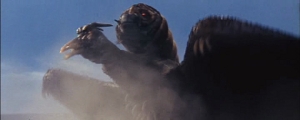
It’s not all good. Some of the puppetry used for monster close-up shots is more than a little obvious. As is the distinct air of goofiness that’s began to creep into the franchise. Godzilla and Rodan bat boulders around like tennis balls. Each breaks down laughing when Mothra begins webbing the other one up. Through the Shobijin’s translation, the three monsters actually communicate with each other and (for the first time) with the audience. We get the clear sense that these creatures are beginning to transcend their origins as walking-nuclear-fallout stand-ins and become something else: characters. It’s their first step towards the dead land of caricature.
But I won’t let my Venusian powers of prognostication stop me from enjoying this film. It’s my second-favorite of the Showa series and one of my favorite Godzilla movies of all time. It’s got a great cast of old pros and fresh new faces, great script, direction, editing, everything. Even the matte work impressed me. Sometimes, matte shots are so damn seamless its taken me this long just to recognize them for what they are. And that’s saying something.
It’s the aesthetic high point of the Japanese monster movie, one of those eternal treats for kids from one to ninety-two. Find it, see it, own it, love it. But if you want real goofiness…just sit right there and wait until this series next alien invasion.
![]()
![]()
![]()
![]()
